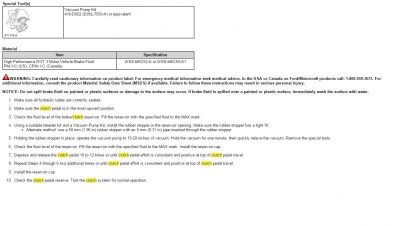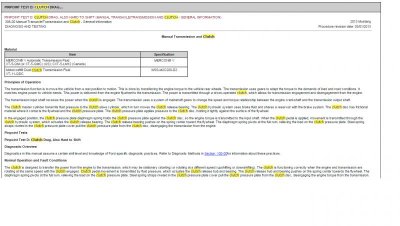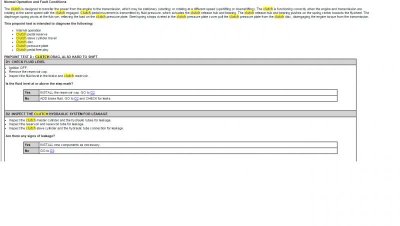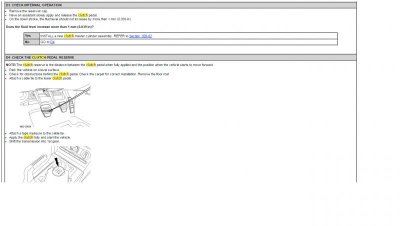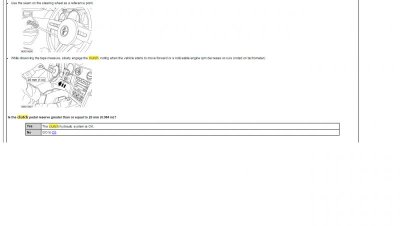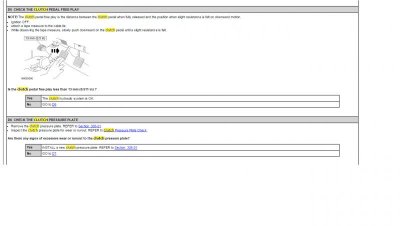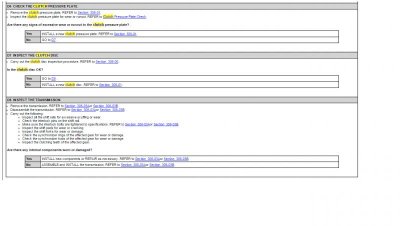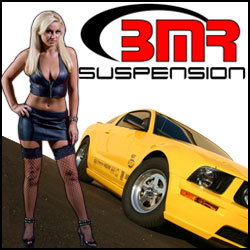Here you go you can read the procedures then use the images from above to see the diagrams! if you go forward with any of the steps that involve checking the disc or pressure plate and trans let me know I will get you those steps as well. The bleeding procedure image you can actually read, so I didn't copy that.
Pinpoint Test D: Clutch Drag, Also Hard to Shift
Diagnostic Overview
Diagnostics in this manual assume a certain skill level and knowledge of Ford-specific diagnostic practices. Refer to Diagnostic Methods in Section 100-00for information about these practices.
Normal Operation and Fault Conditions
The clutch is designed to transfer the power from the engine to the transmission, which may be stationary (starting) or rotating at a different speed (upshifting or downshifting). The clutch is functioning correctly when the engine and transmission are rotating at the same speed with the clutch engaged. Clutch pedal movement is transmitted by fluid pressure, which actuates the clutch release hub and bearing. The clutch release hub and bearing pushes on the spring center towards the flywheel. The diaphragm spring pivots at the fulcrum, relieving the load on the clutch pressure plate. Steel spring straps riveted in the clutch pressure plate cover pull the clutch pressure plate from the clutch disc, disengaging the engine torque from the transmission.
This pinpoint test is intended to diagnose the following:
Internal operation
Clutch pedal reserve
Clutch slave cylinder travel
Clutch disc
Clutch pressure plate
Clutch pedal free play
PINPOINT TEST D : CLUTCH DRAG, ALSO HARD TO SHIFT
D1 CHECK FLUID LEVEL
Ignition OFF.
Remove the reservoir cap.
Inspect the fluid level in the brake and clutch reservoir.
Is the fluid level at or above the step mark?
Yes INSTALL the reservoir cap. GO to D2.
No ADD brake fluid. GO to D2 and CHECK for leaks.
D2 INSPECT THE CLUTCH HYDRAULIC SYSTEM FOR LEAKAGE
Inspect the clutch master cylinder and the hydraulic tubes for leakage.
Inspect the reservoir and reservoir tube for leakage.
Inspect the clutch slave cylinder and the hydraulic tube connection for leakage.
Are there any signs of leakage?
Yes INSTALL new components as necessary.
No GO to D3.
D3 CHECK INTERNAL OPERATION
Remove the reservoir cap.
Have an assistant slowly apply and release the clutch pedal.
On the down stroke, the fluid level should not increase by more than 1 mm (0.039 in).
Does the fluid level increase more than 1 mm (0.039 in)?
Yes INSTALL a new clutch master cylinder assembly. REFER to Section 308-02.
No GO to D4.
D4 CHECK THE CLUTCH PEDAL RESERVE
NOTE:The clutch reserve is the distance between the clutch pedal when fully applied and the position when the vehicle starts to move forward.
Park the vehicle on a level surface.
Check for obstructions behind the clutch pedal. Check the carpet for correct installation. Remove the floor mat.
Attach a cable tie to the lower clutch pedal.
Attach a tape measure to the cable tie.
Apply the clutch fully and start the vehicle.
Shift the transmission into 1st gear.
Use the seam on the steering wheel as a reference point.
While observing the tape measure, slowly engage the clutch, noting when the vehicle starts to move forward or a noticeable engine rpm decrease occurs (noted on tachometer).
Is the clutch pedal reserve greater than or equal to 25 mm (0.984 in)?
Yes The clutch hydraulic system is OK.
No GO to D5.
D5 CHECK THE CLUTCH PEDAL FREE PLAY
NOTE:The clutch pedal free play is the distance between the clutch pedal when fully released and the position when slight resistance is felt on downward motion.
Ignition OFF.
Attach a tape measure to the cable tie.
While observing the tape measure, slowly push downward on the clutch pedal until a slight resistance is felt.
Is the clutch pedal free play less than 13 mm (0.511 in) ?
Yes The clutch hydraulic system is OK.
No GO to D6.
D6 CHECK THE CLUTCH PRESSURE PLATE
Remove the clutch pressure plate. REFER to Section 308-01.
Inspect the clutch pressure plate for wear or runout. REFER to Clutch Pressure Plate Check.
Are there any signs of excessive wear or runout to the clutch pressure plate?
Yes INSTALL a new clutch pressure plate. REFER to Section 308-01.
No GO to D7.
D7 INSPECT THE CLUTCH DISC
Carry out the clutch disc inspection procedure. REFER to Section 308-00.
Is the clutch disc OK?
Yes GO to D8.
No INSTALL a new clutch disc. REFER to Section 308-01.
D8 INSPECT THE TRANSMISSION
Remove the transmission. REFER to Section 308-03Aor Section 308-03B.
Disassemble the transmission. REFER to Section 308-03Aor Section 308-03B.
Carry out the following:
Inspect all the shift rails for excessive scuffing or wear.
Check the interlock pins on the shift rail.
Make sure the interlock bolts are tightened to specifications. REFER to Section 308-03Aor Section 308-03B.
Inspect the shift pads for wear or cracking.
Inspect the shift forks for wear or damage.
Check the synchronizer rings of the affected gear for wear or damage.
Check the synchronizer hubs of the affected gear for wear or damage.
Inspect the clutching teeth of the affected gear.
Are there any internal components worn or damaged?
Yes INSTALL new components or REPAIR as necessary. REFER to Section 308-03Aor Section 308-03B.
No ASSEMBLE and INSTALL the transmission. REFER to Section 308-03Aor Section 308-03B.



